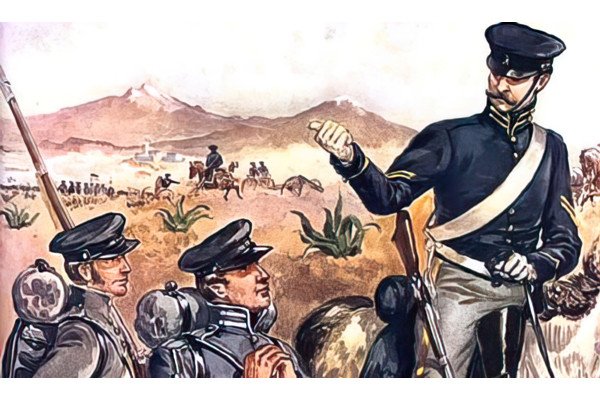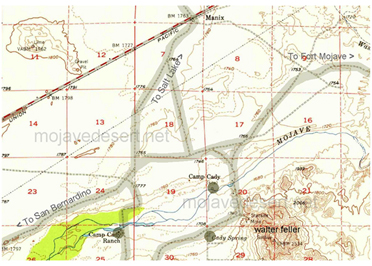History of Camp Cady
by Colonel Herbert M. Hart, USMC (retired)Executive Director, Council on America's Military Past

"Half a days pull through heavy sandy and gravelly wastes brought us to this God-forsaken Botany Bay of a place," wrote Elliott Coues when he visited Camp Cady in 1865, "the meanest I ever saw for a military station, where four officers and a handful of men manage to exist in some unexplained way in mud and brush hovels."
The comparison of Cady to the notorious Australian convict colony was apt, although not calculated to raise the morale of the troopers manning the desolate outpost. It had been built in early 1860 by then Major Carleton at the site of a "Depot on the Mojave," a temporary camp of the preceding September.
Carleton's men had no intention of staying at the spot and were content to live in a scattering of adobe and brush huts, half underground dugout style. There was a central building which could lay some claim to fortress like attributes, a 40-foot adobe square that stood man-high and was surrounded by a ditch.
From here, Carleton vigorously scoured the countryside for traces of Indian marauders. Surgeon Jonathan Letterman, the originator of the Army's ambulance service and after whom Letterman Army Medical Center was named was with Carleton at the time.
An officer "killed two Indians on the 19th in the mountains southwest of our camp," Letterman later wrote. "In the affray two men were seriously wounded, one in the neck and one in the abdomen, by the Indians. Both are doing well, but the one wounded in the abdomen is not out of danger yet." The Los Angeles Star carried news of a Carleton expedition in May, 1860 in which he destroyed a Piute rancheria 50 miles from Cady, bringing away several trophies highly prized by the Indians." A civilian teamster was missing "and it supposed that he was killed by the Indians. These Piutes must get a thorough drubbing."
Rather than a drubbing, Carleton held a peace conference at Camp Cady with 24 Piutes spokesmen, one of them a woman. He told them that the white man and his "Great Father" was powerful and wanted to be a friend of the Indians. The chiefs agreed, gave their pledges, took their gifts, and, for the moment, keep the peace. Camp Cady was abandoned.
Two years later the post was temporarily reactivated, but this time as an early warning outpost against feared Confederate attack. Orders were issued on April 5, 1862 for an 11-man detail to to to Camp Cady "and there shelter yourself and party in a field-work which was thrown up at that point by Colonel Carleton two years since. It is reported that there is a large body of men east of Beale's Crossing on the Colorado River, and it is possible, though not probable, that they will attempt to enter California by the Mojave route."
"The object of sending you to Camp Cady is to give the colonel commanding timely notice, if such be their purpose, and to send to him any intelligence which you may receive of their movements. By putting your men and animals inside of the work, spies or a small number of scouts from such a party, coming up the river, would not know of your presence until they come so close that their escape would be impossible."
The officer commanding the detail was told to stay out 11 days, "when if you receive no intelligence of the body of men alluded to above, you will return by easy marches to your proper station."
A month later, the patrol was back. It had stayed at Cady from April 14 to 24 "seeing and hearing of nothing unusual." Enroute they had heard of wagon loads of powder and small groups of armed men moving on other routes, but their direction was generally northeasterly, and did not seem to pose a threat to California.
The Indian depredations finally caused Cady to return to the official orders on July 26, 1864. Captain John C. Cremony and his B Company of the Second California Cavalry were ordered to patrol from Cady to Rock Springs and "to protect travel, clear the road of thieving, troublesome Indians." A year later, the murder of two men 18 miles from the post, and activities of Indians who "come down from the mountains on either side of the road, steal stock, rob houses, lay forced tribute on travelers, threaten lives" forced the reopening of Camp Cady by a company of cavalry.
They were told to maintain a camp guard of 15 men. "The balance of the men will patrol the road constantly ... keeping it clear ... and particularly to keep Indians away from the watering places," was the guidance to the first detail sent out in March, 1865.
While reestablishing the post, three soldiers were wounded and government stores burned in an Indian attack. The camp was officially reactivated on April 23, 1865, when Company C, 4th California Volunteer Infantry arrived. They manned Cady until July, 1866, rebuilding its collapsed buildings. "The quarters are made entirely of brush and are intended for shelter from the sun only." wrote an observer.
On January 10, 1866, Inspector Brevet Brigadier General C. A. Whittier visited the post. "Great credit is due to Captain West for the construction of neat and comfortable houses with the means at his disposal save the adobe and at no expense to the government Whittier reported, "for the cleanliness and good order prevailing through the camp and for the care of his command and general good administration of affairs."
The following day, the Cady garrison was officially commended by General McDowell for building 35 adobes at the post.
An attempt was made to abandon the camp in 1866, but public and political pressure was too great. Hardly was the post back in business again when a party of Indians approached the fort in a hostile demonstration. Twenty troopers charged after them. Five soldiers were killed in an ambush set up in the dense undergrowth along the river.
In the aftermath, a posse arrived from San Bernardino to reinforce the fort and chase the Indians, but the enemy had disappeared.
Attacks continued on the road. With requirements for pursuit patrols and train escorts, upwards of 120 men manned the fort at times.
In 1868 the post was moved a half mile to the west. Here was sufficient level ground for a parade field, something missing at the first cramped site. A more formal post was built in a rectangle, but a year later the garrison was cut to a token force. By this time, the trail was known as the "Old Government Road" for it had been supplanted by a more direct and safer route.
In 1871 the buildings were sold to civilian men. The mission was finished and the unsentimental Army no longer had any use for shanties. reported to "be of adobe and . . . of little value."
Camp Cady
Mojave Desert History: Military & the Mojave Road ... The encampment was called Camp Cady for Major Albemarle Cady, 6th Infantry, then in command of Fort ...Camp Cady
Camp Cady Mojave Desert Army Outpost. ... Camp Cady was located on the Mojave Road which connected Los Angeles to ... History of Camp Cady · People in ...Covert Observations at Camp Cady
Mojave Desert History - Pioneer of the Mojave ... [I] arrived at Camp Cady on the 14th of April, A. D., 1862, seeing and hearing of nothing unusual on the route, ... Location of Camp Cady I & II
Location of Camp Cady I & II